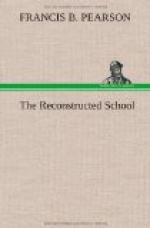Integrity in its large import implies physical soundness, mental soundness, and moral soundness. In time we may come to realize that physical soundness and mental soundness are but sequences of moral soundness, or, in other words, that a sound body and a sound mind are manifestations of a right spirit. But, for the present, we may waive this consideration and think of the three phases of integrity—physical, mental and moral. If, at the age of eighteen years, the boy or girl emerges from school experience sound in body, in mind, and in spirit, society will affirm that education has been effective. To develop young persons of this type is a work that is worthy the best efforts of the home, the school, the church and society, nor can any one of these agencies shift or shirk responsibility. The school has a large share of this responsibility, and those whose duty it is to formulate a course of study may well ask themselves what procedure of the school will best assist the child to attain integrity by means of the school activities.
In our efforts to generate this quality of integrity, or, indeed, any quality, it must be kept clearly in mind every day and every hour of the day that the children with whom we have to do are not all alike. On the contrary, they differ, and often differ widely, in respect of mental ability, environment, inheritances, and native disposition. If they were all alike, it would be most unfortunate, but we could treat them all alike in our teaching and so fix and perpetuate their likeness to one another. Some teachers have heard and read a hundred times that our teaching should attach itself to the native tendencies of the child; yet, in spite of this, the teacher proceeds as if all children were alike and all possessed the same native tendencies. Herein lies a part of the tragedy of our traditional, stereotyped, race-track teaching. We assume that children are all alike, that they are standardized children, and so we prescribe for them a standardized diet and serve it by standardized methods. If we were producing bricks instead of embryo men and women our procedure would be laudable, for, in the making of bricks, uniformity is a prime necessity. Each brick must be exactly like every other brick, and, in consequence, we use for each one ingredients of the same quality and in like amount, and then subject them all to precisely the same treatment.




